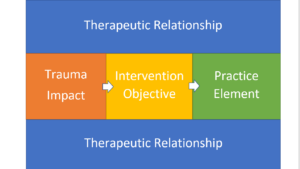Overview of the Core Components and Skills for Trauma-Informed Practice
 Core Components and Skills for Trauma-Informed Practice
Core Components and Skills for Trauma-Informed Practice
This course will promote understanding and use of twelve trauma-informed practice elements and skills, identified in an earlier research study (Strand, Hanson, Courtney, 2013) as the most commonly occurring across evidence trauma treatments. It builds on an earlier course – the Core Concepts of Child and Adolescent Trauma – and conceptualizes a trajectory of intervention that considers the impact of trauma as articulated in the core concepts, the intervention objective that the therapist has in mind to ameliorate the impact of trauma, and then identifies a practice element that will be used to meet that objective. Effective use of trauma-informed practice elements involves the interconnection of these factors in the context of a sound therapeutic relationship.
The following diagram illustrates this trajectory:
 Trauma Impact– Explains the impact of trauma.
Trauma Impact– Explains the impact of trauma.
Intervention Objective – Therapist’s goal for mitigating the impact of trauma.
Practice Element – How, or the skill used to meet the intervention objective.
Therapeutic Relationship – Therapeutic alliance characterized by genuineness, warmth, positive regard, empathy, and affirmation.
In trauma treatment, the use of practice elements has a specific goal – to prepare [e.g., through ameliorating emotional dysregulation, reducing cognitive distortions, maintaining behavioral control] and sustain [e.g., by increasing family communication] the client in the trauma processing phase of work. While this course is not designed to be a substitute for an evidence-based trauma treatment EBTT, familiarity with these 12 commonly occurring practice elements help the clinician target and strengthen intervention with traumatized children and their families and prepare the learner for training in an EBTT.
